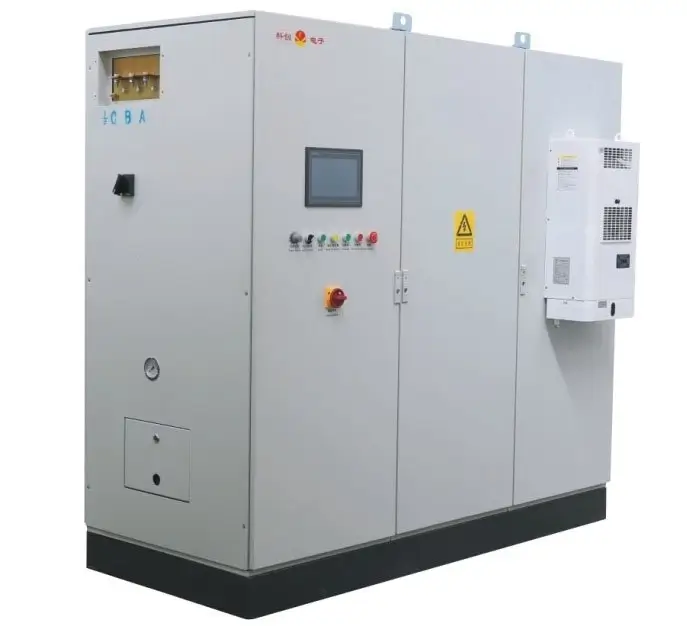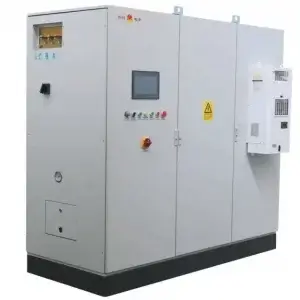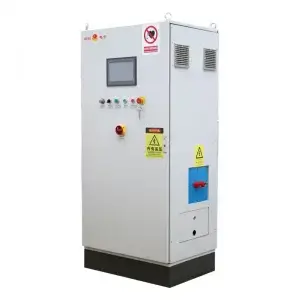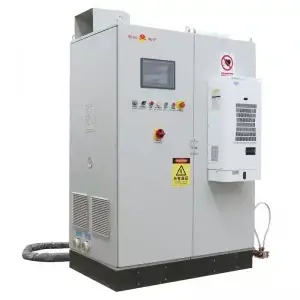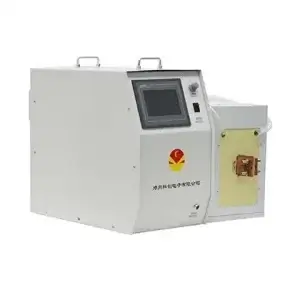Core Features of Automatic Induction Forging Equipment
Combining the technical advantages of induction heating and automated control, these features are tailored for professional promotion of industrial equipment:
1. Intelligent Induction Heating System
- High/Frequency Precision Temperature Control:
Utilizes IGBT/DSP digital control technology to achieve ±2°C temperature accuracy, with a heating frequency range of 1–100 kHz (dynamically adjustable based on workpiece size and material). - Non-Contact Electromagnetic Induction:
Directly heats metal workpieces via alternating magnetic fields, eliminating open flames and oxidation layers while reducing material waste (scale formation reduced by 80%). - Multi-Zone Independent Temperature Control:
Segmented heating coil design supports differentiated heating of different workpiece sections (e.g., end preheating + middle through-heating) to meet complex forging process requirements.
2. Fully Automated Process Control
- PLC/HMI Integrated Control:
Programmable Logic Controller (PLC) + touchscreen Human-Machine Interface (HMI) with pre-set 100+ process recipes, enabling one-click recall and parameter fine-tuning. - Robotic Loading/Unloading System:
Paired with industrial robots for automatic loading, flipping, and unloading, achieving a cycle speed of 15–60 times per minute to minimize human intervention. - Closed-Loop Feedback Regulation:
Real-time monitoring of current, voltage, and temperature data, with automatic compensation for grid fluctuations to ensure heating consistency (temperature variation ≤±1.5%).
3. High Efficiency, Energy Saving, and Environmental Protection
- Resonant Power Supply Design:
Power conversion efficiency ≥95%, saving 30–50% energy compared to traditional resistance furnaces, compliant with GB 25324-2020 Energy Efficiency Grade 1 standards. - Closed-Loop Cooling System:
Equipped with plate heat exchangers and constant temperature control, ensuring cooling water temperature difference ≤5°C and water resource utilization >90%. - Low Harmonic Pollution:
Adopts PWM rectification technology, with Total Harmonic Distortion (THD) <5%, eliminating the need for additional filtering devices.
4. Precision Forging Capabilities
- Uniform Thermal Penetration:
Specialized coil designs (e.g., multi-turn spiral, saddle-shaped) ensure core-to-surface temperature difference <10°C, preventing the “black core” defect. - Rapid Heating Rate:
Reaches forging temperatures (1050–1250°C) within 5–20 seconds, shortening production cycles and increasing capacity (single-piece heating time reduced by 40%). - Micro Forging Force Control:
Servo-hydraulic system with pressure accuracy of ±0.5 MPa enables sub-millimeter dimensional control (e.g., φ50mm shaft forging tolerance ≤±0.08mm).
5. Flexible Production Adaptability
- Modular Structural Design:
Independent configuration of heating, forging, and cooling zones, expandable to 5–8 stations for 联动 (coordinated operation), compatible with workpieces from φ10–φ300mm in diameter. - Adaptive Process Switching:
Supports mixed-line production, with AI algorithms automatically matching heating parameters (e.g., power density, heating time), achieving changeover time <15 minutes. - Custom Tooling Development:
Dedicated inductor designs for complex workpieces (e.g., gear blanks, blades), enhancing coupling efficiency to over 92%.
6. Safety and Reliability Assurance
- Multiple Protection Mechanisms:
Automatic alarm and shutdown for over-temperature, over-current, and water shortage, with dual temperature monitoring (infrared + thermocouple) to ensure equipment failure shutdown rate <0.5%. - Industrial-Grade Durability:
Uses water-cooled cables (temperature resistance >200°C) and silver-plated copper busbars (conductivity >98% IACS), with key component lifespan >80,000 hours. - CE/ISO Certification:
Compliant with EU Machinery Directive 2006/42/EC, EMC Directive 2014/30/EU, and other international standards.
